Alexander the Great’s Father Discovered in Tomb, Study Claims

© AP Photo / Petros Giannakouris
Subscribe
King Philip II of Macedonia was assassinated in 336 BC in Aegae at the age of 46. He was the 18th king of Macedonia, and ruled from 359 until 336 BCE after succeeding his brother, and is credited with the military knowledge he used to expand his empire.
Archaeologists first made the discovery of three royal tombs containing the remains of the family of Alexander the Great in the 1970s. But since its discovery, researchers have debated which members of the royal family were buried in which tombs. A controversial new study claims a previous study incorrectly identified the remains.
The burial site where the members of the Macedonian royal family are believed to rest is known as the “Great Tumulus”. The site is located in the archaeological site of Aega and was the first capital of Macedonia. It can be found next to the modern town of Vergina in Northern Greece, and 65 km (40 miles) west of Thessaloniki.
At the site are three tombs that were built sometime during the fourth century BC, and upon their initial discover it was assumed that the remains included King Philip II (Alexander the Great’s father, Alexander IV (the posthumous son of Alexander IV), and King Philip III Arrhidaeus (the elder half-brother of Alexander the Great).
In the new study, led by Antonios Bartsiokas, a professor of anthropology at the Democritus University of Thrace in Greece, the researchers believe King Philip II and King Philip III Arrhidaeus were misidentified as each-other.
“The skeletons studied are among the most historically important in Europe,” says Bartsiokas and fellow researchers. “We have focused our discussion on the scientific facts and historical evidence that impacts acceptance or rejection of the location of King Philip II of Macedonia.”
While most scholars agree that the third tomb—Tomb III—belongs to Alexander IV, the identities of the first two tombs have remained unresolved. The new study claims that Tomb I belongs to Alexander the Great’s father, and Tomb II belongs to the historical figure’s half-brother.
The first tomb also contains the remains of a young adult female and her baby. Researchers believe these remains belong to King Philip II’s wife, Cleopatra, and their newborn child. Bartsiokas reasons that this is the identity of the young female and not Euridice as was previously believed—the wife of King Philip III—as Cleopatra was assassinated along with her newborn child, Bartsiokas explains.
Philip II also suffered a severe injury to his left knee, which skeletal evidence shows, the study adds.
"His skeletal evidence and the pattern of his cremated bones have been shown to be consistent with the circumstances of the death of King Arrhidaeus and his wife," Bartsiokas said.
"Tomb I was a very small and poor tomb and Tomb II was very big and rich. This ties with the historical evidence that Macedonia was in a state of bankruptcy when Alexander started his campaign and very rich when he died. This is consistent with Tomb I belonging to Philip II and Tomb II belonging to his son Arrhidaeus."

Visitors walk behind an ancient marble head of ancient Greek warrior-king Alexander the Great, displayed at the Acropolis museum in Athens, Oct. 12, 2014. Alexander the Great was one of the world's most successful military commanders, who enlarged his father's kingdom to include an empire stretching from modern Greece to India. During his youth, Alexander was tutored by the ancient Greek philosopher Aristotle until the age of 16.
© AP Photo / Petros Giannakouris
“We have provided compelling evidence from multiple sources that shows conclusively that Philip II was buried in Tomb I,” the study argues. “Our hypothesis of Philip II in Tomb I remains unchallenged in peer-reviewed literature and we believe the available evidence is conclusive.”
Alexander the Great was born in 356 BCE at Pella in Macedonia to Philip II and Olympias. He was tutored by Aristotle from the age of 13 to 16. When he was older, he fled with his mother to Epirus following his parent’s divorce. After reconciling with his father, King Philip II was assassinated and Alexander became king. Alexander died at the age of 32, but the cause of his death has been widely debated. His tomb is also considered to be lost to history.





